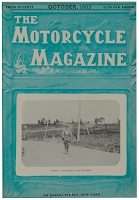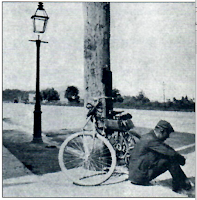(Clinton, IA)
Wyman did not account for his activities on June 17, 1903. In the passage below, he states he departed the Stoddart Hotel in Marshalltown at 7 am, Tuesday, on "July 16"(sic - should be June 16), clearly a transcription error that made into the September 1903 issue of
The Motorcycle Magazine. (See page 145, right column, last paragraph)
"With my nerve fortified by a resolve to brazen it out with the section hands on the railroad, and a stock of interesting stories arranged in mind for their benefit, I left Marshalltown at 7 a.m. on July 16, and proceeded to the tracks of the Northwestern."
It is likely Wyman remained overnight in Cedar Rapids, repairing his motorcycle at Hall Bicycle Company on Second Avenue. Then finding overnight accommodations, departing for Clinton on the 17th of June.. It was over "77 miles" from Marshalltown to Cedar Rapids. And, another 85 miles from Cedar Rapids to Clinton. Wyman cites his daily mileage, likely traveled on June 17th.
"Darkness overtook me before I reached Clinton, and, being afraid of smashing into something. I walked the last few miles into that place, arriving at 9 p.m., after having covered eighty-five miles."
Wyman's next date/time reference is when he departs Clinton at 6:30 am on June 18, heading north to cross the Mississippi over the "Lyons-Fulton Bridge." There is another transcription error in the reference to "Dixon" instead of Clinton. Dixon is community east of and after going through Fulton, just across the Mississippi river. Wyman goes on to mention "Fulton" correctly in the passage below. (See page 147, first full paragraph)
"At Clinton I was nearing Chicago, within 150 miles of it, and on the morning of June 18, when I left Clinton, Ia, at 6:30 a.m., I hoped to reach it before noon on the following day. Shortly after leaving Dixon(sic. Clinton) about two miles, I crossed the "Father of Waters" and was at last east of the Mississippi and into Illinois, where I was told at the start I never would get with my motor bicycle. The roads improved at once after crossing the great river, though I had some difficulty finding the correct one going out of Fulton, Illinois."

It is remarkable there are relatively so few transcription errors in the whole of the Wyman narrative. If you think of the communication flow-process that was necessary to end in the final printed copies of The Motorcycle Magazine articles.
Wyman would have to keep a journal of his daily progress, noting dates, times, locations and a descriptive narrative about activities. He also had with him a Kodak Vest Pocket camera that he used to take pictures along the way.
At the end of each riding day, after tending to the motorcycle, getting fed and securing lodging, he would compile his notes into a narrative suitable for publication. Then, depending on the telegraph, telephone and postal services available in the place he stopped for the night, he had to package it up and send it to Goodman Company publishing facilities in San Francisco and/or New York City. He never mention getting film developed so one can assume it was sent to the publisher for processing. Also, we imagine the editorial staff at the Goodman Company offices would polish the narratives before sending the copy to the press for typesetting and printing. So, the opportunity for "copy errors" were ever present.
Across America on a Motor Bicycle - "Through The Valleys Of The Two Great Rivers To Chicago" by George A. Wyman, The Motorcycle Magazine, September 1903, Vol 1 No 4
Omaha, NE to Chicago, IL
June 12 to June 19, 1903
























